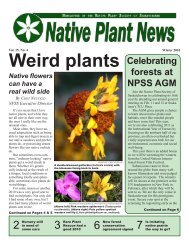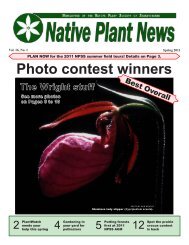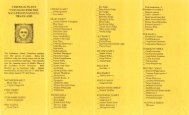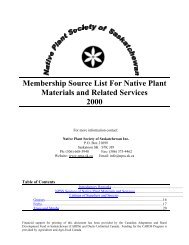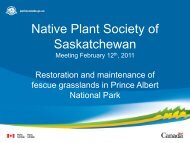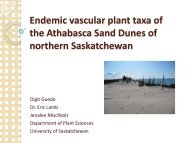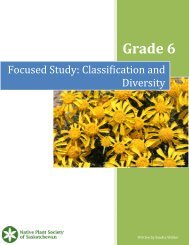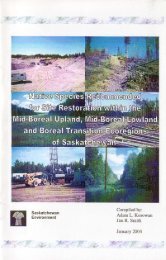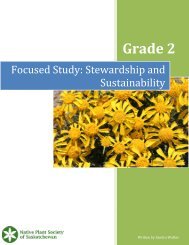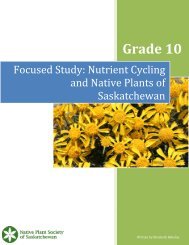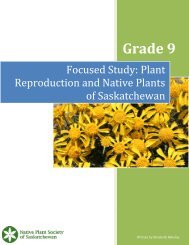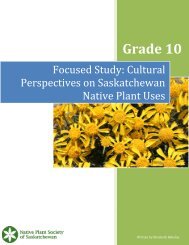Grade 11 Lesson Plan - Native Plant Society of Saskatchewan
Grade 11 Lesson Plan - Native Plant Society of Saskatchewan
Grade 11 Lesson Plan - Native Plant Society of Saskatchewan
You also want an ePaper? Increase the reach of your titles
YUMPU automatically turns print PDFs into web optimized ePapers that Google loves.
<strong>Grade</strong> <strong>11</strong>Focused Study: Ecosystems,Survival and <strong>Native</strong> <strong>Plan</strong>ts <strong>of</strong><strong>Saskatchewan</strong>Written by Elizabeth Bekolay
The <strong>Native</strong> <strong>Plan</strong>t <strong>Society</strong> <strong>of</strong> <strong>Saskatchewan</strong> is a strong advocate <strong>of</strong> natureeducation.In addition to this lesson plan, we also support schools by:- providing free printed resources.- leading field tours.- delivering outdoor and classroom presentations.- hosting opportunities to "ask an expert", where students can interact with a pr<strong>of</strong>essional biologist orrelated occupation though in person events or Skype. In some cases, we can arrange for Frenchspeaking experts.We also support the establishment <strong>of</strong> native plant learning gardens on school grounds by <strong>of</strong>fering freenative seeds, printed resources, personal visits, presentations and expert advice to help with all stages<strong>of</strong> the process. The gardens can be as small as a square meter.All <strong>of</strong> what we do is always free for participating schools.Does any <strong>of</strong> this sound like something you'd want? If so, please call us at (306) 668-3940 or e-mail us atinfo@npss.sk.caFree Electronic Resources on the <strong>Native</strong> <strong>Plan</strong>t <strong>Society</strong> <strong>of</strong> <strong>Saskatchewan</strong> Website (www.npss.sk.ca)A Guide to Small Prairie Restoration - How to Grow Your Own Patch <strong>of</strong> <strong>Native</strong> Prairie<strong>Saskatchewan</strong>'s <strong>Native</strong> Prairie: Taking Stock <strong>of</strong> a Vanishing Ecosystem and Dwindling Resource (Alsoavailable in print)On the Prairie - A webpage on our site with a "Build a Prairie" game, field guide to prairie plants andanimals, curriculum goodies like a English-Dakota language guide, and virtual reality panoramas <strong>of</strong>prairie placesThe Watershed GameFree Printed Materials Available Through the <strong>Native</strong> <strong>Plan</strong>t <strong>Society</strong> <strong>of</strong> <strong>Saskatchewan</strong>:<strong>Native</strong> <strong>Plan</strong>ts, Water and Us! (Booklet)<strong>Native</strong> <strong>Plan</strong>ts, Water and Us! (Poster)<strong>Native</strong> <strong>Plan</strong>t Communities <strong>of</strong> <strong>Saskatchewan</strong> (Poster)<strong>Native</strong> <strong>Plan</strong>t Communities <strong>of</strong> <strong>Saskatchewan</strong> (Activity Sheet)
FOCUSED STUDY: ECOSYSTEMS, SURVIVAL AND NATIVE PLANTS OFSASKATCHEWANGRADE <strong>11</strong>OVERVIEW AND PURPOSETo become acquainted with the ecology <strong>of</strong> different bioregions in <strong>Saskatchewan</strong> through an imaginedsurvival scenario and to understand how change happens through succession in plant communities. Awalk outside in a local natural area is integral to this study.OUTCOMES AND INDICATORSBiology 20Unit 2: Ecological Organization2. Analyze a variety <strong>of</strong> ecosystems.2.7 Investigate a natural community in the neighbourhood <strong>of</strong> the school.6. Recognize ecological sequencing.6.2 Review several examples <strong>of</strong> biomes by discussing some <strong>of</strong> their major kinds <strong>of</strong> plants.Unit 4: Agricultural Botany <strong>of</strong> <strong>Saskatchewan</strong>2. Appreciate the relation <strong>of</strong> <strong>Saskatchewan</strong>'s biogeographical regions and agricultural activity.2.4 Identify various species <strong>of</strong> trees, shrubs, plants and grasses <strong>of</strong> <strong>Saskatchewan</strong>.MATERIALSThe internet. Pens, pencils, paper.Free publications from the <strong>Native</strong> <strong>Plan</strong>t <strong>Society</strong> <strong>of</strong> <strong>Saskatchewan</strong>:<strong>Native</strong> <strong>Plan</strong>ts, Water and Us!<strong>Native</strong> <strong>Plan</strong>t Communities <strong>of</strong> <strong>Saskatchewan</strong> Poster<strong>Saskatchewan</strong>’s <strong>Native</strong> Prairie: Taking Stock <strong>of</strong> a Vanishing Ecosystem and Dwindling ResourceINTRODUCTIONBy this grade level a student should have a good understanding <strong>of</strong> what a native plant is. However, it isalways beneficial to reinforce and remind. A plant native or indigenous to <strong>Saskatchewan</strong> is one that hasevolved here. This means that it was here prior to European contact. <strong>Native</strong> plants are adapted to theirspecific climatic zone and soil type. There are both native aquatic plants and terrestrial plants. <strong>Plan</strong>tsthat are not native are considered ‘introduced’ or ‘exotic’. If these introduced species spread rapidlyand out-compete other plants in an ecosystem they are considered ‘invasive’ or sometimes referred toas ‘noxious weeds’. <strong>Native</strong> plants are part <strong>of</strong> the biodiversity that help to keep our ecosystems healthy.They support a vast number <strong>of</strong> species that have evolved with them in an intricate relationship. The loss<strong>of</strong> this biodiversity has an impact throughout the ecosystem resulting in species endangerment andextinction. It is important to promote a sense <strong>of</strong> respect through ecological knowledge <strong>of</strong> place.<strong>Plan</strong>ts play a major role in our survival. <strong>Plan</strong>ts are food, and materials for shelter and clothing. They aremedicine for our bodies and our spirits. They provide food and habitat for the animals and insects thatthe ecosystems depend on for renewal. In this lesson your students will form a closer connection towhat it means to be dependent on plant life.
INSTRUCTIONAL METHODSThis is a guided inquiry, a simulation.You will ask your students to form research groups <strong>of</strong> 4 or 5 to study the different biomes by ecoregionin <strong>Saskatchewan</strong> (See below).Set up a map <strong>of</strong> the province on a table. Blindfold one person from each group, have them approachthe table and point to a location in <strong>Saskatchewan</strong>. It is on this site that your activity will focus.Alternatively, have the groups draw their ecoregion from a hat/box to ensure covering most or all <strong>of</strong> theecoregions in the province.In this simulation the research groups will be a small family unit. The land that they point to on the mapis where they have to immigrate to in order to survive. They need to learn as much as they can aboutthe ecology <strong>of</strong> this ecoregion in order to survive.All you have are each other and the knowledge that you have gained: What will you use for food? (what plant and animal species are present?) Describe the various trees, shrubs, flowering plants, grasses, fungi and lichen. What will you use for shelter? How will you survive the winter? What will you have to do in each season to survive? What will you use for medicine? What cultures live here in the present? What cultures lived here in the past? How did First Nations survive here before European colonization? Could you survive here in the same way today? What has changed since then?
http://esask.uregina.ca/entry/ecozones_and_ecoregions.htmlFind your ecozone. Are you inthe Prairie, Boreal Plain, BorealShield or Taiga Shield ecozone?Locate your ecoregion tonarrow your plant ID search.This link provides a list <strong>of</strong> plants expected in each ecoregion in <strong>Saskatchewan</strong>http://www.biodiversity.sk.ca/Docs/expplbyeco.pdfThis link provides a list <strong>of</strong> all the animal and invertebrate species in each ecoregion in <strong>Saskatchewan</strong> –http://www.biodiversity.sk.ca/Docs/Expbyeco.pdfThis link gives all the landscape area names found in the lists above and information on ecoregions –http://www.biodiversity.sk.ca/eco.htm
The Atlas <strong>of</strong> <strong>Saskatchewan</strong> is an excellent resource for information on archeology and timelines <strong>of</strong> thetribes who occupied different territories at different times in history. For example, it is believed that inthe late 1600’s in <strong>Saskatchewan</strong> the Dene occupied the farthest regions north, and the Cree were south<strong>of</strong> the Dene, without overlapping territories. South <strong>of</strong> the Cree in east central <strong>Saskatchewan</strong> were theNakota, and in west central <strong>Saskatchewan</strong> were the Blackfoot. South <strong>of</strong> the Blackfoot were the Atsinaand the Snake peoples and in the farthest parts <strong>of</strong> the south east were the Hidatsa, a people who grewannual crops whose bean varieties still exist today.Getting Outside:After the students have done some <strong>of</strong> their research, take them to a local ecosystem, help them toidentify local species, ask them if these species are similar to the ones they studied in their survivalscenario. If one group studied your area in particular, have them lead the group and teach the sessionon local biodiversity.ASSESSMENT:Have the students present their research and survival plan to each other. They will be teaching eachother about the different ecoregions, and the plant and animal species that live there. Have each groupcome up with a set <strong>of</strong> questions, based on the ecology and cultural history <strong>of</strong> the area, for the class toanswer after their presentation.RESOURCESBooks:Aikenhead, G. and H. Michell. 20<strong>11</strong>. Bridging Cultures: Indigenous and Scientific Ways <strong>of</strong> KnowingNature. Pearson Canada. Toronto.Grant, T. and Littlejohn, G. 2010. Greening School Grounds: Creating Habitats for Learning. New<strong>Society</strong> Publishers. Gabriola Island.Hammermeister, A., D. Gauthier and K. McGovern. 2001. <strong>Saskatchewan</strong>’s <strong>Native</strong> Prairie: Taking Stock<strong>of</strong> a Vanishing Ecosystem and Dwindling Resource. <strong>Native</strong> <strong>Plan</strong>t <strong>Society</strong> <strong>of</strong> <strong>Saskatchewan</strong>. Saskatoon.Johnson, D., L. Kershaw, A. MacKinnon, and J. Pojar. 1995. <strong>Plan</strong>ts <strong>of</strong> the Western Forest: Alberta,<strong>Saskatchewan</strong> & Manitoba Boreal Forest & Aspen Parkland. Lone Pine Publishing and the CanadianForest Service. Edmonton.Keane, K. and D. Howarth. 2003. The Standing People: Field Guide <strong>of</strong> Medicinal <strong>Plan</strong>ts <strong>of</strong> the PrairieProvinces. Root Woman and Dave. Saskatoon.Lahring, H. 2003. Water and Wetland <strong>Plan</strong>ts <strong>of</strong> the Prairie Provinces. Canadian Plains Research Center.Regina.Neufeld, C. 2010. <strong>Saskatchewan</strong>’s Prairie Places. <strong>Native</strong> <strong>Plan</strong>t <strong>Society</strong> <strong>of</strong> <strong>Saskatchewan</strong>. Saskatoon.<strong>Saskatchewan</strong> Indian Cultural Centre. 2009. Cultural Teachings: First Nations Protocols andMethodologies. Available through the <strong>Saskatchewan</strong> Indian Cultural Centre:http://www.sicc.sk.ca/index.html
<strong>Saskatchewan</strong> Indian Cultural Centre. 2009. Practicing the Law <strong>of</strong> Circular Interaction. First NationsEnvironmental & Conservation Principles Binder. Available through the <strong>Saskatchewan</strong> Indian CulturalCentre: http://www.sicc.sk.ca/index.htmlSavage, C. 20<strong>11</strong>. Prairie: A Natural History. Greystone Books. Vancouver.Wruck, G. and K. Gerein. 2003. <strong>Native</strong> <strong>Plan</strong>ts, Water and Us! <strong>Native</strong> <strong>Plan</strong>t <strong>Society</strong> <strong>of</strong> <strong>Saskatchewan</strong>.Saskatoon.Websites:Center for Ecoliteracyhttp://www.ecoliteracy.org/essays/systems-thinkingThe <strong>Native</strong> <strong>Plan</strong>t <strong>Society</strong> <strong>of</strong> <strong>Saskatchewan</strong>http://www.npss.sk.ca/<strong>Saskatchewan</strong> Indian Cultural Centrehttp://www.sicc.sk.ca/index.htmlUniversity <strong>of</strong> <strong>Saskatchewan</strong> Herbarium Rare <strong>Plan</strong>ts Indexhttp://www.usask.ca/biology/rareplants_sk/root/htm/en/index.php/Gabriel Dumont Institutehttp://www.metismuseum.ca/media/document.php/<strong>11</strong>389.pdfReferences:Fung, Ka-iu. 1999. Atlas <strong>of</strong> <strong>Saskatchewan</strong>. University <strong>of</strong> <strong>Saskatchewan</strong>. Saskatoon.Johnson, D., L. Kershaw, A. MacKinnon, and J. Pojar. 1995. <strong>Plan</strong>ts <strong>of</strong> the Western Forest: Alberta,<strong>Saskatchewan</strong> & Manitoba Boreal Forest & Aspen Parkland. Lone Pine Publishing and the CanadianForest Service. Edmonton.Wruck, G. and K. Gerein. 2003. <strong>Native</strong> <strong>Plan</strong>ts, Water and Us! <strong>Native</strong> <strong>Plan</strong>t <strong>Society</strong> <strong>of</strong> <strong>Saskatchewan</strong>.Saskatoon.This project was undertaken with the financial support <strong>of</strong>:Ce projet a été réalisé avec l'appui financier de:



